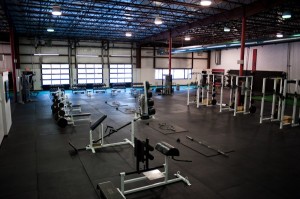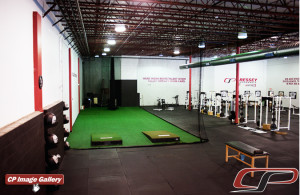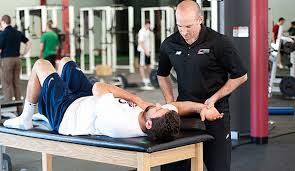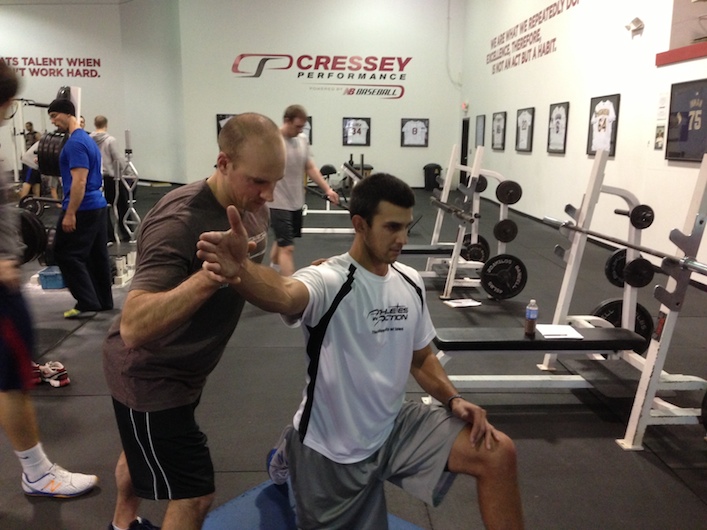Eric Cressey is not only one of the brightest minds in our industry, but also someone I call a good friend.
I’m really excited to wrap up “Athletic Development” month here at RTS with an interview with EC, focusing on his target niche, baseball.
Enjoy!
————
Eric, thanks for taking the time to be with us here today. It’s been a little while since we’ve chatted, so could you start by telling us a bit about yourself?
I’m just doing my best to make people realize that Mike Robertson and Eric Cressey are, in fact, two different people!
 Kidding aside, Cressey Performance – the facility I co-founded in 2007 – has been going strong for almost seven years. The majority of our clientele is baseball players, and we saw more than 100 professional players – representing all 30 Major League Baseball organizations – during the 2013-14 off-season.
Kidding aside, Cressey Performance – the facility I co-founded in 2007 – has been going strong for almost seven years. The majority of our clientele is baseball players, and we saw more than 100 professional players – representing all 30 Major League Baseball organizations – during the 2013-14 off-season.
In the past three years, we’ve had more than 40 athletes drafted in the MLB Draft. So, needless to say, the baseball niche has been good to us – and we really enjoy catering to this underserved population.
Additionally, I do a lot of writing, speaking, consulting, and product development.
Cool. You’ve obviously been doing this for a while now, so when did you realize that you wanted to chase a career in strength and conditioning?
I realized I wanted to be in the fitness industry in some capacity around my sophomore year of my undergraduate studies. I had originally been planning to become an accountant and was studying at Babson, which at the time was the #1 entrepreneurial school in the country for something like nine years in a row!
In spite of the prestige of the school, I found myself more passionate about the science side of things, especially in light of the fact that I’d been really sick my freshman year and looked to weight training and proper nutrition to regain weight I’d lost.
I wound up transferring to the University of New England after my sophomore year, and graduated with a double major in exercise science and sports and fitness management. Thereafter, I was fortunate to be accepted into the University of Connecticut’s Kinesiology Graduate Program.
When I arrived at the UCONN, I was a little unsure about where my graduate school experience would take me, although I was leaning toward becoming a hardcore geek and doing loads of research.
Then, I met Brijesh Patel and Pat Dixon – two graduate assistant strength coaches at UCONN – and hit it off immediately with both of them.
These guys really took me under their wing in my first few weeks on campus. Pat gave me the tour of campus, and Brijesh took the time to chat with me about anything related to training, nutrition, and life in general.
Perhaps most importantly, these two guys brought me into the UCONN varsity weight room to train, and it was there that my love of coaching really went to a whole new level.
The day I met Brijesh, he invited me to come to watch him coach the baseball guys the next morning at 6AM. I showed up without thinking twice. The passion “B” displayed for coaching and his complete control over an indoor track full of 25 college guys were really remarkable – especially since he did it in a very mild manner.
B isn’t one of those coaches who needs to scream and yell at you all the time to make you better, and I’ve really modeled myself from his example. Perhaps most impressively was that every one of those players was wide awake at the crack of dawn; they were anxious to be coached by a guy whom they obviously respected tremendously as someone who could get them to where they needed to be.
This was obviously a handful of years ago, but my coaching career has absolutely skyrocketed since then; I owe a lot of this success to B. He made me realize that I wanted to be “that guy” for my athletes.
Okay, now let’s get to the good stuff. You’re obviously most well-known for training professional baseball players – how did you get started in that niche?
I think it’s a classic example of opportunity being where luck meets preparation.
When I first moved to Boston, it just so happened that some of the first athletes I took on as clients were high school baseball players. Long story short, they had some great results: their team won the Division 1 state championship and one of them was state player of the year. The Boston Globe ran an article about my work with them, and my phone started ringing off the hook.
I’ve always been a baseball fan, and really enjoyed working with the guys. And, in light of my own significant shoulder injury history, I could apply a lot of the expertise I already had immediately.
So, I dedicated myself to learning everything I could about that population – and a big part of it was asking a lot of questions and being a good listener. That’s an approach I carry forward to this day even though I’m well-versed on the “goings-on” of the typical baseball year. I want our athletes to know that we’re managing them on a 100% individualized basis.
Anyway, as the years went on, high school guys became college guys and pro guys. And, they had teammates, agents, and coaches who were singing our praises and referring them our way. We grew 100% by word of mouth.
That’s awesome, and a testament to what you guys are doing!
We’re going to hammer this baseball-training focus for a couple of questions. What are some of the big mistakes that rookie coaches make training baseball players?
Many coaches make the mistake of falling to one extreme or the other.
On one hand, many coaches think baseball players are just like other athletes, so you can just hand them the “football program.” On the other hand, you have coaches who coddle guys excessively so that nothing productive takes place; players are effectively in “rehab” all the time.
I firmly believe that baseball players can be pushed really hard as long as you are aware of the unique demands of their sport and the key adaptations. It sounds very simple, but the truth is that very few people actually understand these demands and adaptations.
As examples, it’s hard to debate the risk/reward profile of snatches in baseball players when you don’t even have enough knowledge of the elbow to even understand what “valgus stress” means.
And, you can’t say that back squats are perfectly fine for throwers if you aren’t familiar with the concept of humeral anterior glide, and can’t appreciate that throwers have very loose anterior capsules already. I point these knowledge shortcomings out not to belittle anyone’s knowledge or sound all high and mighty, but rather to simply observe that you can’t criticize what you don’t understand.
 This lack of knowledge is one reason we started up with our Elite Baseball Mentorships, and they’ve been a great success.
This lack of knowledge is one reason we started up with our Elite Baseball Mentorships, and they’ve been a great success.
Taking that a step further, build us your ideal baseball player. What physical skills or capacities does he have?
This is the great thing about baseball: there isn’t one body type that helps you succeed! Part of this comes because many players are successful because of traits and not just athleticism. They may have more congenital laxity (loose joints), better vision, longer fingers, or something to that effect.
That said, I think your chances of making it to the big leagues would be maximized with the following:
- left-handed pitcher,
- height of 6-3 or 6-4,
- long arms and legs, short torso,
- *some* congenital laxity, but not excessive hypermobility (I’d take a mid-range score on the Beighton Hypermobility Test),
- long fingers, and
- meso- or ectomorphic.
So, effectively, think David Price, Jon Lester, or Clayton Kershaw. They’re doing okay for themselves, aren’t they?
Of course, there are guys who have bits and pieces of this “ideal” and do great. One of our clients, Tim Collins, is the shortest pitcher in MLB (5-7), but he can make up for his lack of height with good reactive ability, the right amount of laxity, and an unreal curveball.
I think it comes back to realizing that different guys throw hard via different mechanisms. I’ve seen guys who just have insanely quick arms, and others who just use their body really efficiently to generate velocity. The former case allows guys to get away with being a bit less athletic, whereas the latter case demands that they really be good athlete.
That’s an awesome answer. Following up on that, you’ve talked quite extensively about arm care – especially for pitchers.
What is arm care? And why should baseball players care about it?
Arm care – as the name implies – is whatever a player does to try to keep his arm healthy. Shoulder and elbow injury rates are sky-high these days, so this is a big deal.
The problem is that not all arm care programs are created equal.
There are an insane number of variables impacting the efficacy of the program, and they’re changing constantly throughout the year. I think one of the reasons for our success at Cressey Performance is that we appreciate the relationships among all these variables.
One thing I’d add is that we’re constantly emphasizing that a good arm care program is really a full-body care program. You can do all the upper body work you want, but if your core and lower body aren’t strong and mobile, you’re really just covering 1/3 of what’s needed.
Playing devil’s advocate here, can’t we just do a couple of sets of internal and external rotations with a band and call it a day?
And if not, what do you include in an arm care routine?
The answer would be a resounding NO!
As for what we would include, it would be based on the assessment of the athlete. This seems obvious, but you’d be amazed: every Major League Baseball organization has one arm care program they give out to all their players.
If not all players are starting in the same place, how can the same road map get them to their ideal destination?
That said, if I looked at the commonalities of all our programs, just about all our guys do positional breathing, wall slides variations, back-to-wall shoulder flexion, prone table arm care drills (particularly Ys and Ts), external rotations (manual resistance, cable, and/or band), and rhythmic stabilizations.
Everyone does soft tissue work. Some guys may get some manual stretching, but a lot of our guys are so loose that they do absolutely no stretching at all.
And, as I noted above, this is a complement to the rest of their strength and conditioning programs.
Excellent. Let’s switch gears slightly and talk about the core. Controlling extension is a very hot topic these days, and it’s something you and I have both discussed in the Elite Training Mentorship.
How do you define controlling extension? And how does it apply to baseball players?
To me, “controlling extension” is a matter of establishing and maintaining a neutral posture in the sagittal plane.
With most baseball players, we’re working hard to learn how to turn off the lats while getting the anterior core, glutes, and lower traps engaged. This is a gross oversimplication, but I think it illustrates that we’re talking about a full-body thing, whereas many people believe it to just be an examination of core posture.
Certainly, that’s part of it, but what you’ll often find is that athletes find ways to compensate above or below the core. Maybe they hyperextend their knees, shoot into forward head posture, or drive back into humeral extension with the lats.
The issue is that baseball guys heavily ingrain this extension pattern more than your typical extension-rotation sport athletes. Throwing a baseball is incredibly lat-intensive. In fact, research has demonstrated that professional pitchers use 200% more lat recruitment in throwing than their amateur counterparts.
So, they have to be long and strong – and with good tissue quality.
The problems we face are that guys don’t know how to shut them off. As an example, when doing a prone 1-arm trap raise, lat dominant individuals may try to yank down into scapular depression instead of getting true scapular posterior tilt. This would be the lat substituting for the lower traps. This video goes into more detail:
Most coaches who work with athletes put them into buckets. For instance a football strength coach may have the big boys in bucket, position players in another, quarterbacks in a third, etc.
Do you do this with baseball players? And if so, how do you split them up?
I think the most common approaches we see in the baseball world are dividing guys into pitchers, catchers, and position players. To some degree, we do this – but it’s a tip of the iceberg.
You see, relief pitchers are going to be different than starters. Outfielders are different than catchers, or first basemen.
I’d say the biggest differences, though, come in right- vs. left-handed players. The right handed guys usually present as left AIC/right BC (as per the Postural Restoration Institute). They have unilateral dominance, on top of normal structural asymmetry, combined with the fact that they live in a right-handed world. Left-handed players tend to work their way out of it a bit.
Okay let’s switch gears a bit. New baseball player comes to you for an assessment – what does that assessment process consist of?
We always start off by sitting down with the athlete to gather pertinent information. Obviously, this includes an injury history, but I’m also curious about whether he bats/throws left- or right-handed, what position he plays, how many innings he pitched in the previous year, what he wants to improve, etc.
I’m fine with spending 15-20 minutes or so just talking with an athlete. I don’t think enough coaches really listen; they jump too quickly to “telling.”
While we’re still in the office, I’ll have the athlete take his shirt off and we’ll go through some assessments of static posture, scapular control (flexion, abduction, external rotation with the arms adducted and abducted, etc.), rotator cuff strength, toe touch, Beighton hypermobility score, and any of a number of other tests that may come to mind based on what I see (or what they report).
 From there, we’ll head out to the gym and use one of the training tables for all our range-of-motion assessments. Obviously, there’s a particular focus on shoulder and elbow ROM. Beyond just ROM, though, I’m curious about end-feel, whether there is clicking/popping, if an ulnar nerve is hypermobile, etc.
From there, we’ll head out to the gym and use one of the training tables for all our range-of-motion assessments. Obviously, there’s a particular focus on shoulder and elbow ROM. Beyond just ROM, though, I’m curious about end-feel, whether there is clicking/popping, if an ulnar nerve is hypermobile, etc.
It’s not just a matter of the degree to which they get; it’s how they get there.
We can pair these observations up with what see in the office to get a clearer picture of overall movement. As an example; if a standing shoulder flexion test is loaded with compensation patterns, you can pair it with a supine shoulder flexion test to determine if it’s an issue of short or stiff.
Next, we’ll stand an athlete up and start getting to some functional tests, including overhead squats, overhead lunge walk, standing unilateral hip flexion, and wall ankle mobility.
Finally – but most importantly – we’ll actually get in a good training session on the first day. This is a great opportunity to introduce/coach a foam rolling, warm-up, and strength training session that addresses whatever issues we observed during the preceding evaluation. And, we learn more by just watching them move and respond to cues.
Summarily, you could say that day 1 is about gathering information, building rapport, and actually getting a training effect in place. The last thing you want to do is just tell people everything that’s wrong with them for an hour, and then send them on their way.
I really like that approach, and it’s something we’ve tried to do more of at IFAST.
Last but not least, you have a very integrated approach to training baseball players. You have your staff, Matt Blake (a pitching coach), Chris Howard (massage therapist), etc. How do you feel that impacts your ability to get results?
It’s absolutely huge.
Being able to pair up our assessments with Matt’s is really powerful. Video analysis, in particular, is a game-changer, as you can easily identify an athlete’s limitation and directly point out how it relates to his performance, injury history, and future risk.
Additionally, Matt can pick up on things we might not have a chance to observe, whether it’s the spin on the ball, what a guy is doing with his glove side, or any of a number of other factors. There is a “test-retest” approach on the throwing side of things just like there is one on the strength and conditioning side of things.
Having Chris has been equally valuable. His soft tissue work helps guys to bounce back quickly between throwing sessions, and he’s often working hand-in-hand with one of our physical therapists to complement an athlete’s rehabilitation.
Really, though, those two guys are just the tip of the iceberg; we intentionally hired each of our staff members so that they’d serve specific roles within our system. In other words, we didn’t try to replicate employees; we tried to complement them.
Additionally, we’ve built a big network of everything from orthopedic surgeons, to hitting coaches, to baseball coaches, to agents, and a host of other entities. If we don’t have the answer, we can find it for our athletes very quickly!
Okay, let’s start to wrap this thing up a bit. What advice do you give to your interns on being successful in our industry?
Wow, we cover a lot of stuff with them over the course of 3-5 months, so it’s tough to hone in on just a few things.
That said, if I had to pick one, it would be simply that a client has to like you before he/she likes training with you.
Let’s face it: not everyone enjoys exercise like us fitness professionals do. However, if they can enjoy the people with whom they exercise, it’s going to increase adherence – and they’re going to work a lot harder while they’re at the gym. So, we emphasize building rapport and always showing a genuine interest in people and their unique needs.
Of course, it’s also important to never stop learning; surround yourself with motivated and unconditionally positive people; and always take care of the little things (e.g., showing up on time) instead of just getting preoccupied with the sexy stuff. Of course, none of this matters if people don’t like you, so I stand by my #1!
Last but not least, what is one mistake that you’ve made training baseball players, and how did you learn from it and grow either as a coach, professional, or human being?
Like a lot of people, I used to prescribe the sleeper stretch – probably until about 2009. Fortunately, we’ve learned of better ways to improve shoulder internal rotation – positional breathing, manual therapy, and gentle cross-body stretching – that don’t have the same negative effects we get with the sleeper stretch.
I’d say that the biggest lesson it taught me is that change is hard, but usually worthwhile.
We’d taught the sleeper stretch to a lot of our young athletes, and then made the “bold” move to eliminate it from the program. This meant that we not only had to help athletes to know what to do instead, but also why they were doing something different.
And, for about six months, we were constantly telling athletes to stop doing the stretch. Nowadays, though, you won’t see it in our facility. In fact, at least a few times a week, I counsel throwers on why they shouldn’t use it.
I guess you could say that it’s always easier to add something to your philosophy than it is to take something away. With that in mind, always scrutinize everything you consider bringing into your system, or else it might be a lot of work for you down the road when you’re trying to “undo” it.
Eric, thanks a ton for being with us here today. Where can my readers find out more about you?
Thanks for having me.
I’ll give you four websites:
www.EricCressey.com is my personal website, where I publish a free newsletter and daily blog.
www.CresseyPerformance.com is the website for our facility.
www.EliteBaseballMentorships.com is the website for our baseball mentorships. The next upper extremity course will be this June.
www.HighPerformanceHandbook.com is the website for my latest product, The High Performance Handbook. It’s a four-month program that is a pretty up-to-date representation of some of my approaches to training.
Thanks again Eric!

